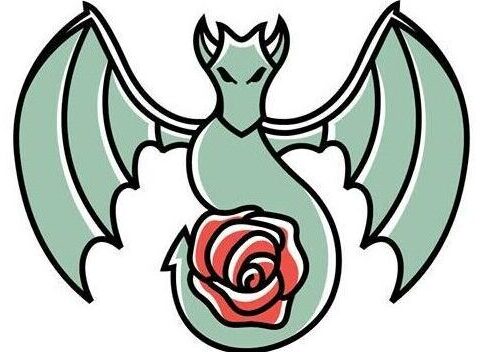
Every rosarian wants to have huge, healthy roses. One of the keys to this is to properly care for and feed the soil.
Chemical fertilizers such as Miracle-Gro certainly nourish your roses with minerals and nutrients. However, they don’t add anything to the soil. Chemical fertilizers are like multivitamins: They do you good, but in the long run, it’s best to eat a balanced diet. In terms of soil health, the “balanced diet” comes from feeding the soil. When you add plenty of organic material to the soil, you start a process that works for both the soil and the plants that grow in it.
Microorganisms break the organic material down, making the soil looser and more crumbly. Earthworms further break the organic material down, then expel it in the form of worm castings. If you’ve ever seen how plant roots wrap around worm burrows, you’ve seen for yourself how much plants love the nutrients that worms make available in the soil. Also, the burrows bring air deep into the ground and ease soil compaction, which is also good for roots.
But there are many other organic ingredients that you can add to the soil to improve it, as well as stimulants to boost growth in your roses.
This is not a comprehensive list by any means, but any of these will be helpful in your rose garden. You can rotate fertilizers, change one out for another over the year. Or if your local nursery runs out of one fertilizer, you can grab another of these off the list and still be fine.
Greensand – This is an organic soil amendment that you don’t hear a lot about, but it’s great for soil. It’s a material called glauconite, mined from where the ocean floor used to be (i.e. New Jersey), and contains many of the nutrients and minerals you’d find in seawater (except salt). It’s an especially good source of potash (which stimulates photosynthesis in plants), and also silica, magnesia, iron oxide, lime and phosphoric acid, and 22 trace minerals.
It’s a slow-release fertilizer (0-0-3) but it’s a great conditioner for clay soils, improving its texture and loosening it up nicely. It also helps sandy soil retain moisture. Greensand absorbs and holds water very well. Apply this at about a quarter-pound per square foot of soil, or 50 to 100 pounds per 1,000 square feet. You can dig it into the soil when planting your roses, or broadcast it over the top of the soil, or even add it to your compost to enrich it.
Blood or bone meal – This is dried, powdered blood from slaughterhouses that’s high in nitrogen and iron. This should be added to the soil and dug in, because if you use this as a top-dressing (i.e. sprinkle it on top of the soil), dogs and cats and critters will be nosing around and licking your mulch.
Blood meal is supposed to keep rabbits away. I think it’s because all these dogs and cats come into your yard to investigate that delicious smell. Till it in when using, or water it in to keep your dog friends away.
Manure – Manure is generally low in minerals, but it’s one of the best soil conditioners, adding much-needed organic matter to the ground that breaks down very nicely to humus, which plants love. But, more important, manure is a biologically-active material, busy with microorganisms and bacteria that are the powerhouses that keep your soil busy and alive.
Fish emulsion – The cats will come running when you start watering your plants with this! But it’s an excellent source of nitrogen and the plants love it. Roses especially. Fish Bliss is a nice brand.
Fish bits – If you’ve been fishing and have finished filleting your fish, take the stinky parts and bury them in the garden and water them in. Then you’ll grow a fish tree!
No, actually, fish bits are great for plants. It’s said that when the Seneca planted corn, they put a fish in the soil by every plant. It works for roses, too. But water after planting your fish so you wash away the fish smell and the animals don’t dig it up. (If you do get a fish tree, please give me a call.)
Epsom salts – The magnesium in this stops blossom-end rot in tomatoes and helps roses to grow new canes. Put a half-cup around each plant once a year. However, if you have a high-salinity soil with too much salt in it, skip this step.
Tea and coffee grounds – These contain nitrogen, and make a super mulch for acid-loving plants. They seem to stimulate growth in some plants, too. I watered my orchids with a little coffee added to a cup of water, and they greened up nicely. The caffeine acts as a stimulant for them too. They probably won’t need a pot every morning, though, thanks.
Cottonseed meal – Good for adding nitrogen. This by-product from cotton manufacturing is good for acid-loving plants, which includes roses. I tried it as a mulch but was unimpressed, as it tended to repel water. Generally when I’d put this down, I’d lay some wood chips on top to help keep it moist. This might work better as a soil amendment and as a top-dressing for plants (one cup per rose).
Kelp and seaweed fertilizers – Kelp fertilizers can be applied as a granular fertilizer, or used as a foliar fertilizer that can be sprayed on the leaves. Kelp contains many trace nutrients, and may possibly contain small amounts of growth stimulants that will give you lush foliage and richly-colored blossoms. Seaweed sprays, on the other hand, can be sprayed as a foliar feed once a month, and might possibly help your leaves become more resistant to fungal diseases (blackspot and powdery mildew).
